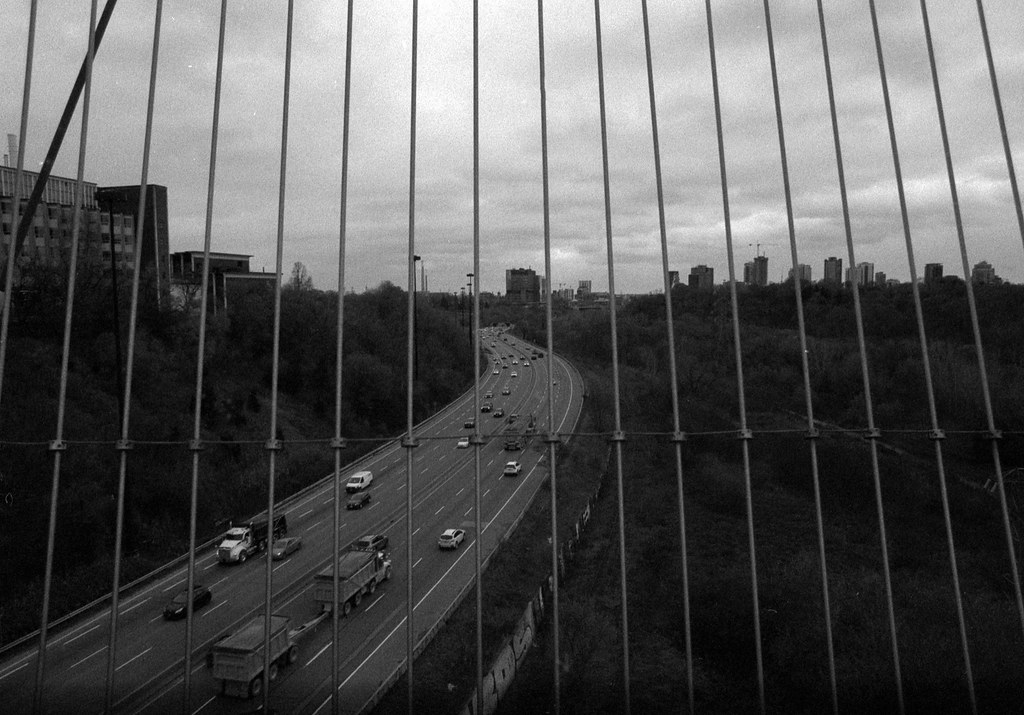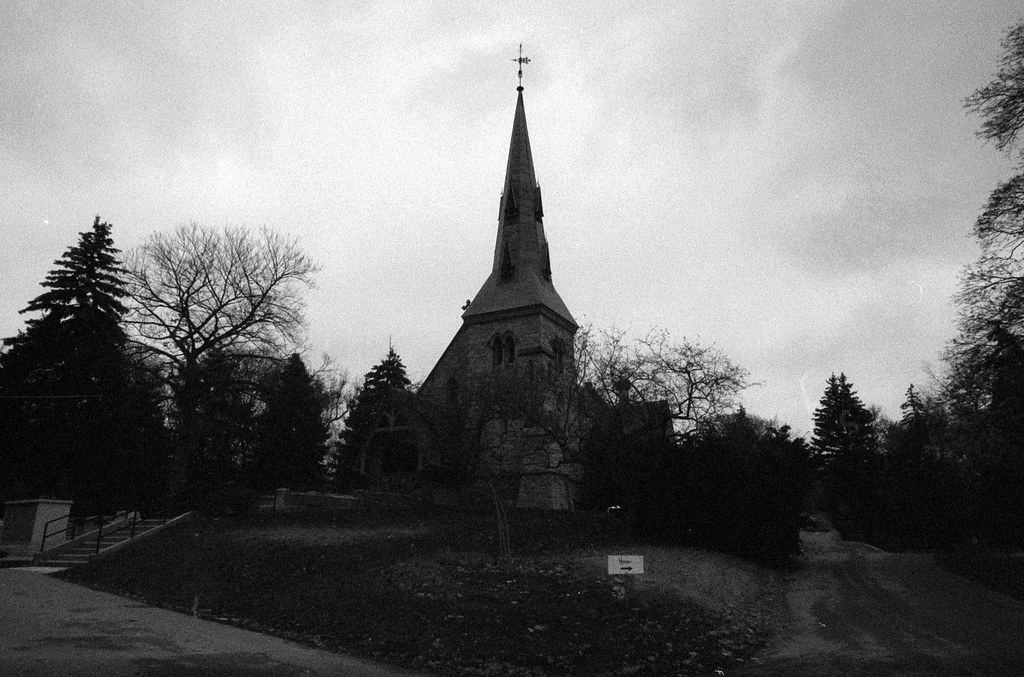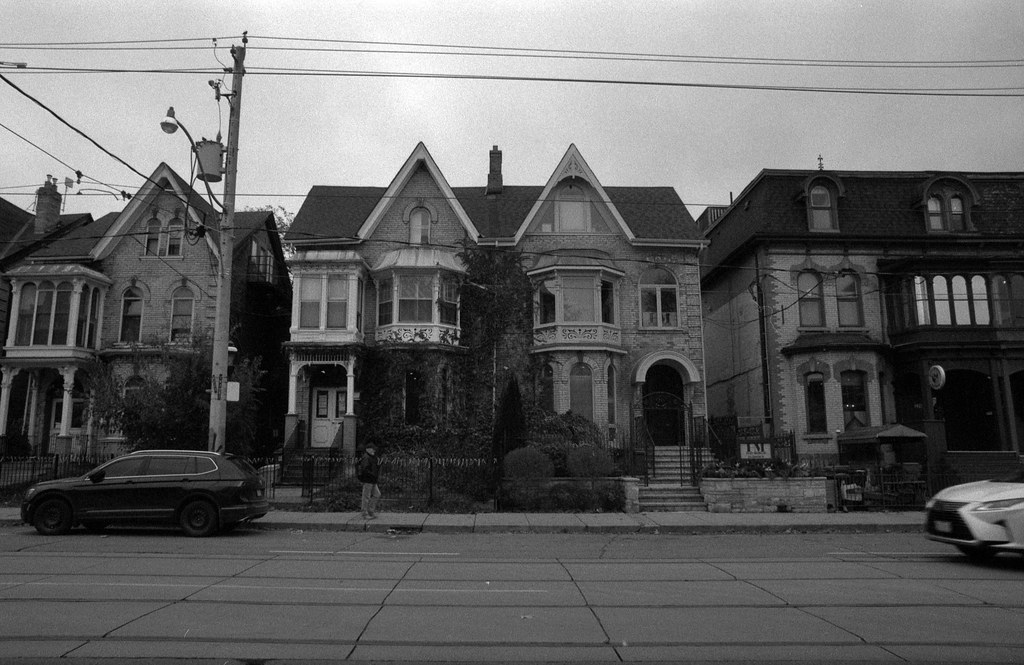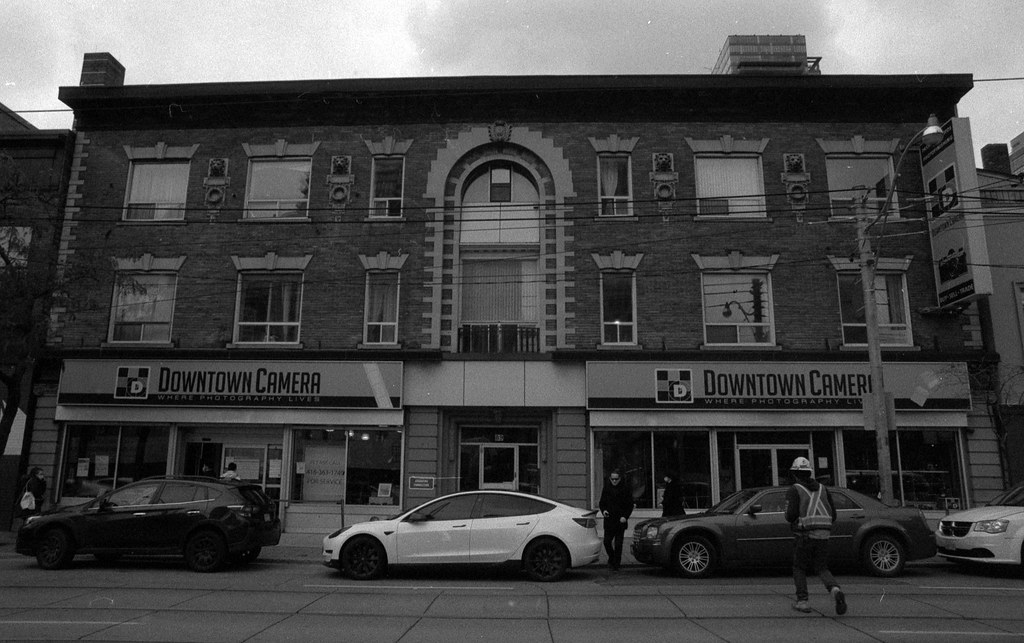It’s funny that for this year’s 52-roll project, the city of Toronto that has in the past featured prominently has taken more of a minor role this time around. With all the restrictions placed on us this year, I have found myself purposefully avoiding the city. But when my friend John Meadows asked me to be a part of his project, I jumped on a visit to Toronto. After spending time at The Only, I decided to take the hour and a half walk from Greektown on the Danforth to downtown Toronto to stock up on supplies at Downtown Camera.

Nikon FM – AI Nikkor 24mm 1:2.8 – New Classic EZ400 @ ASA-200 – Pyrocat-HD (1+1+100) 12:30 @ 20C
Having already told the grand history of the City of Toronto, I will be avoiding that subject this time around. Instead, I’ll be speaking to the story of my walk and the smaller stories of the areas of Toronto I passed through. My walk started up on the Danforth, a rather famous stretch of road and The Only Cafe. At The Only, I visited with my good friend John Meadows and participated in the portrait project he’s been working on, and I can see why he speaks highly of the place. Sadly I did not get a photo of the joint before walking west through Greektown. Officially located along The Danforth between Chester and Dewhurst, the area first formed through the second decade of the 20th century, although the city’s ethnic Greek population lived in a different part of the city at this point, an anti-greek riot in 1918 dispersed the population. It wasn’t until the military coup in Greece that led to Junta rule from 1967-74 that the area became a focal point of many Greek Immigrants, many of whom fled from the Military government. The area quickly became North America’s largest Greektown through the 1970s and 1980s and officially took Greektown on The Danforth in 1993. It’s appeared in the movie My Big Fat Greek Wedding and the novel The History of John. It also became a focal point in a deadly shooting in July 2018 that left two dead and thirteen injured. I crossed the Don Valley by the Prince Edward Viaduct, a massive truss arch bridge that carries Bloor Street over the river valley. The Edmund Burke designed bridge carries both vehicles, pedestrian and subway traffic and opened in 1918. And given the name for Prince Edward, then Prince of Wales and the future King Edward VIII (who later abdicated the throne in December 1936). While heavily reinforced for streetcar traffic on the top deck, the controversial lower deck for rail traffic proved to future proof the bridge when the TTC ran their subway line across in 1966. The high bridge proved deadly and became a spot where many took their own life on purpose or by accident, giving it the deadly title of the fatal standing structure in Canada by 2003, second in all of North America. The Luminous Veil, installed in 2003, helped reduce the number of falls from the bridge, although signs with support lines still stand at either end. After crossing the bridge, I turned south, passing by St. James Cemetery, Toronto’s oldest cemetery that remains in use today. First opened in 1844, it became the final resting place of the city’s Anglican population and is known for The Chapel of James-The-Less, a beautiful Victorian Gothic structure. Over time, the cemetery became non-denomination and holds Canada’s first casualties of War, the Ridgeway 13, a group of soldiers from The Queen’s Own Rifles who died at the Battle of Ridgeway. After passing through St. Jamestown, I found myself in Cabbagetown, once home to several Irish immigrants; the area is known for its beautiful Victorian and Second Empire homes. Cabbagetown came in the late 19th century when many poor immigrants dug up the front lawns to plant cabbage for food. Despite the grand architecture, many of the houses were rented by the working class, and through the 20th century, the income bracket continued to decline. The area became one of Toronto’s largest slums. Although much of the original housing was lost during redevelopment in the 1940s. Thankfully the 1970s saw new bylaws prevent the loss of many historic buildings, although today, many people who call the area home are being priced out due to gentrification. After travelling south on Parliament, I turned west again on Carlton, where many historic homes reside, then crossed southwest through Allan Gardens. The gardens are the brainchild of George William Allan, who donated the land to the Toronto Horticultural Society in 1858, who established gardens in 1860. The area came under the control of the city’s government, which allowed the society to continue their garden but allowed the public access to the space. The central structure known as the Palm House is the third such structure, completed in 1910 and replaced an earlier structure burned down. Then back across Gerrard and down Church skirting the edges of the Ryerson University/University X, established in 1948 and named for Egerton Ryerson, and recently faced a great deal of backlash due to the ongoing struggles with Colonial and Indigenous relations. Then down Bond Street, because I wanted to walk past the last home of Toronto’s first mayor, the infamous William Lyon MacKenzie and more importantly took a look at the older sections of St. Michael’s Hospital. The hospital had its beginnings in 1892, opened by the Sisters of St. Joseph to care for the poorer population in Toronto’s southern areas. It also became one of Toronto’s first teaching hospitals with a formal agreement with the University of Toronto. And then my final stop, Downtown Camera, my favourite camera shop, which carries a wide range of film and chemistry and is always a stop.

Nikon FM – AI Nikkor 24mm 1:2.8 – New Classic EZ400 @ ASA-200 – Pyrocat-HD (1+1+100) 12:30 @ 20C
Nikon FM – AI Nikkor 24mm 1:2.8 – New Classic EZ400 @ ASA-200 – Pyrocat-HD (1+1+100) 12:30 @ 20C
I will admit, it was a tough week for choosing which images to include in the post. And I am glad that I wrote the narrative of my journey from The Only to Downtown Camera as it certainly helped shape which images to include. Instead of stressing over which photos to form, I went chronologically based on my journey. Starting with the Welcome to Greektown sign, while not my favourite, I should have overexposed it a bit to pull out the shadow detail, and this was the third such sign and the best composition of the three. It also took a bit of patience walking over the viaduct to shoot through the veil. I passed into St. James Cemetery; again, I should have opened up the aperture to fill in the shadows, I was hoping to get a bit more compensation out of the Pyrocat-HD, but sadly, I did not. Another hard choice was which image to include from Cabbagetown, there is so much to shoot, so I went with some of the fine residential architecture on Carlton Street. I had to, of course, include a shot of the Palm House circa 1910 in Allan Gardens. I did avoid capturing the camps for those living rough in the park; it seemed a touch tasteless, in my opinion. Being a history buff, I did have to include the MacKenzie house, which, if you’re in Toronto and can, is well worth a visit to enjoy a bit of Toronto history. MacKenzie is certainly tied directly into both Canadian and Toronto History. And of course, I included the last shot from the roll and my journey, Downtown Camera.

Nikon FM – AI Nikkor 24mm 1:2.8 – New Classic EZ400 @ ASA-200 – Pyrocat-HD (1+1+100) 12:30 @ 20C
Nikon FM – AI Nikkor 24mm 1:2.8 – New Classic EZ400 @ ASA-200 – Pyrocat-HD (1+1+100) 12:30 @ 20C
While my initial place was to bring a standard three lens kit along for the walk, carrying some extra items into Toronto using a backpack rather than my usual messenger bag kept me using a single lens this time around, I went with my trusty Nikkor 24mm f/2.8, given I would be walking through spaces that a wide-angle lens would work with narrow streets and a bit of urban landscape work. Although I probably could have gotten away with either the 28mm f/3.5 or the 35mm f/2.8. Despite being overcast, the day remained bright, allowing me to over-expose the film by a stop and shoot at ASA-200, but I did not use a yellow filter as I did not get any blue skies. For the developer, I went with an old favourite and magic bullet, Pyrocat-HD, as I had enough left for one more roll. The only published time was for Fomapan 400 shot at full box speed, but by reducing the time by 10%, I landed on a better time, and the results are right in line with what I would expect from Fomapan 400. And that did surprise me for the first time, as Pyrocat-HD did a superb job with Fomapan 200. Yet with Fomapan 400, even with the one-stop over-exposure, it’s nothing too special.

Nikon FM – AI Nikkor 24mm 1:2.8 – New Classic EZ400 @ ASA-200 – Pyrocat-HD (1+1+100) 12:30 @ 20C
Nikon FM – AI Nikkor 24mm 1:2.8 – New Classic EZ400 @ ASA-200 – Pyrocat-HD (1+1+100) 12:30 @ 20C
Next week, Heather and I take a well-deserved break from work and head out to Niagara-On-The-Lake for a two-day vacation in Upper Canada’s first capital.